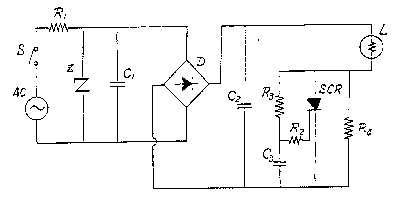Some of the information on this Web page has been provided by external sources. The Government of Canada is not responsible for the accuracy, reliability or currency of the information supplied by external sources. Users wishing to rely upon this information should consult directly with the source of the information. Content provided by external sources is not subject to official languages, privacy and accessibility requirements.
Any discrepancies in the text and image of the Claims and Abstract are due to differing posting times. Text of the Claims and Abstract are posted:
| (12) Patent: | (11) CA 1296758 |
|---|---|
| (21) Application Number: | 1296758 |
| (54) English Title: | APPARATUS FOR LIMITING SURGE CURRENTS IN DC-ILLUMINATED INCANDESCENT LAMP |
| (54) French Title: | APPAREIL DESTINE A LIMITER LES CRETES DE COUVRANT DANS LES LAMPES A INCANDESCENCE A COURANT CONTINU |
| Status: | Expired and beyond the Period of Reversal |
| (51) International Patent Classification (IPC): |
|
|---|---|
| (72) Inventors : |
|
| (73) Owners : |
|
| (71) Applicants : |
|
| (74) Agent: | MACRAE & CO. |
| (74) Associate agent: | |
| (45) Issued: | 1992-03-03 |
| (22) Filed Date: | 1986-02-20 |
| Availability of licence: | N/A |
| Dedicated to the Public: | N/A |
| (25) Language of filing: | English |
| Patent Cooperation Treaty (PCT): | No |
|---|
| (30) Application Priority Data: | ||||||
|---|---|---|---|---|---|---|
|
60-306125
Abstract of the Disclosure
Surge currents which may arise in dc-illuminated incan-
descent lamp can be effectively limited by an apparatus com-
prising a low resistance (first resistance); another resistance
(second resistance); a diode rectifier, the input terminal being
connected in series to an ac source through the first resistance,
and the output terminal being connected in series to an incan-
descent lamp through the second resistance; a voltage regulator
diode connected in parallel with said diode rectifier; a capaci-
tance (first capacitance) connected in parallel to the input
terminal of said diode rectifier; another capacitance (second
capacitance) connected in parallel to the output terminal of said
diode rectifier; a switching device connected to the second
resistance; and a timing circuit connected to said switching
device in a manner that the switching device shorts the second
resistance after a lapse of a prescribed time upon switching-on
of the ac source.
Note: Claims are shown in the official language in which they were submitted.
Note: Descriptions are shown in the official language in which they were submitted.

2024-08-01:As part of the Next Generation Patents (NGP) transition, the Canadian Patents Database (CPD) now contains a more detailed Event History, which replicates the Event Log of our new back-office solution.
Please note that "Inactive:" events refers to events no longer in use in our new back-office solution.
For a clearer understanding of the status of the application/patent presented on this page, the site Disclaimer , as well as the definitions for Patent , Event History , Maintenance Fee and Payment History should be consulted.
| Description | Date |
|---|---|
| Inactive: IPC removed | 2021-05-26 |
| Inactive: IPC removed | 2021-05-26 |
| Inactive: IPC expired | 2020-01-01 |
| Inactive: IPC removed | 2019-12-31 |
| Inactive: IPC from MCD | 2006-03-11 |
| Inactive: IPC from MCD | 2006-03-11 |
| Time Limit for Reversal Expired | 2005-03-03 |
| Letter Sent | 2004-03-03 |
| Inactive: Entity size changed | 2002-01-21 |
| Grant by Issuance | 1992-03-03 |
There is no abandonment history.
| Fee Type | Anniversary Year | Due Date | Paid Date |
|---|---|---|---|
| MF (category 1, 6th anniv.) - small | 1998-03-03 | 1998-02-05 | |
| Reversal of deemed expiry | 2001-03-05 | 1998-02-05 | |
| MF (category 1, 7th anniv.) - small | 1999-03-03 | 1999-02-08 | |
| Reversal of deemed expiry | 2001-03-05 | 1999-02-08 | |
| Reversal of deemed expiry | 2001-03-05 | 1999-12-16 | |
| MF (category 1, 8th anniv.) - small | 2000-03-03 | 1999-12-16 | |
| MF (category 1, 9th anniv.) - small | 2001-03-05 | 2000-12-05 | |
| Reversal of deemed expiry | 2001-03-05 | 2000-12-05 | |
| MF (category 1, 10th anniv.) - standard | 2002-03-04 | 2002-01-08 | |
| MF (category 1, 11th anniv.) - standard | 2003-03-03 | 2003-01-16 |
Note: Records showing the ownership history in alphabetical order.
| Current Owners on Record |
|---|
| KEN HAYASHIBARA |
| Past Owners on Record |
|---|
| KAZUMI MASAKI |